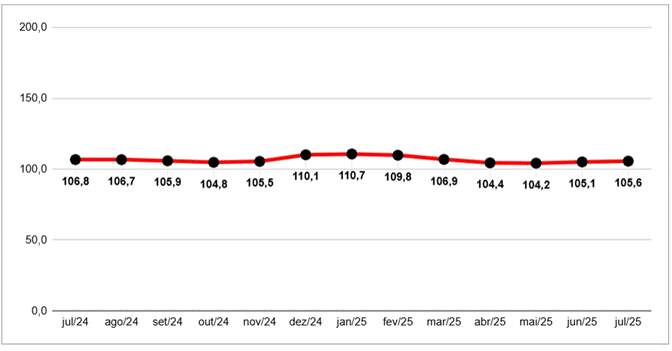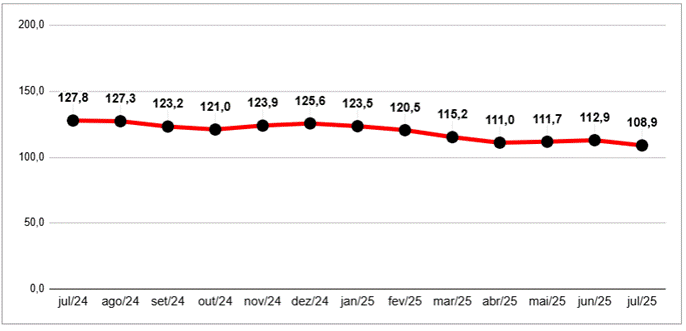Certainly! Here’s a rewritten version of the content with clearer structure and updated phrasing while retaining all original information:
The uncertain economic scenario has impacted the confidence and consumption habits of São Paulo residents, influenced by rising inflation and interest rates. According to the Federation of Commerce of Goods, Services and Tourism of the State of São Paulo (FecomercioSP), in July, the Consumer Confidence Index (ICC) dropped by 3.5% compared to June, reaching 108.9 points [see Chart 1]. Meanwhile, the Family Consumption Intention (ICF) remained stable at 105.1 points [see Chart 2], both still above the optimism threshold of 100 points.
[CHART 1]
Consumer Confidence Index (ICC)
13-month Historical Series
Source: FecomercioSP

On an annual comparison, the ICC experienced a 14.7% decline — marking 12 consecutive months of decrease — reflecting both negative current perceptions and pessimism about the future. The ICF also fell by 1%, signaling that despite short-term improvements, consumers remain cautious.
[CHART 2]
Family Consumption Intention (ICF)
13-month Historical Series
Source: FecomercioSP

According to FecomercioSP, in an economic environment characterized by a high basic interest rate (Selic) at 15%, increased IOF taxes on financial operations, and trade restrictions imposed by the United States, the recovery of consumer confidence is expected to be gradual. The retail sector is particularly affected by high operational costs, restricted credit, elevated interest rates, and subdued demand.
Consumption Outlook Improves, but Durable Goods Remain Weak
Among the seven sub-indices that compose the ICF, five showed growth in July: professional outlook (up 1.7%), timing for durable goods purchases (up 1.7%), consumption outlook (up 1.2%), current consumption level (up 1%), and access to credit (up 0.5%). However, current employment (-0.8%) and current income (-0.6%) declined, indicating concerns over potential labor market instability and erosion of purchasing power [see Table 1].
[TABLE 1]
Family Consumption Intention – Variables
Source: FecomercioSP

The high cost of credit is directly affecting families’ ability to finance larger purchases, as evidenced by a 13.4% annual drop in the timing for durable goods indicator — the largest decline recorded — which remains in the pessimism zone at 69.8 points.
Analyzing by income bracket, consumers earning more than ten minimum wages showed a monthly decrease of 1.2% and an annual fall of 4.2%, reflecting a more restrained consumption pattern influenced by fiscal uncertainty. Despite stable income and credit access, this group demonstrated greater caution, especially regarding immediate consumption and financed purchases.
Conversely, families earning up to ten minimum wages saw the ICF rise by 1.2% monthly and remain practically stable over the year (0.2%), mainly supported by improvements in professional outlook and credit access, driven by policies targeting popular consumption.
Confidence Declines and Purchasing Power Pressured
The ICC sub-indices fell in July. The Current Economic Conditions Index (ICEA) dropped 4.8%, reaching 102.7 points — close to the pessimism threshold. The Consumer Expectations Index (IEC) fell 2.7% for the month and 15.9% over 12 months, settling at 113.1 points. By demographic profile, only women (up 1.6%) and consumers aged 35 or older (up 3.2%) showed slight improvements in confidence.
Among expenditure groups, housing costs increased 0.99% monthly, driven by a 2.96% rise in electricity prices, while the food and beverages category showed a slight deflation of -0.18%. Still, persistently high interest rates and inflation continue to erode families’ purchasing power, complicate credit access, and increase debt levels. This situation heightens reliance on short-term credit lines and underscores financial vulnerability amid potential economic shocks.
[TABLE 2]
Consumer Confidence Index (by income, gender, and age)
Source: FecomercioSP

Recommendations for Retailers
FecomercioSP advises that in a context of more selective and cautious consumption, retail still has room to grow by adopting a strategic and adaptable approach aligned with the new consumer profile — sensitive to prices and attentive to cost-benefit balance. Efficient inventory and cost management is crucial, including adjusting the product mix to demand, reducing low-turnover items, renegotiating with suppliers, and reviewing fixed expenses.
At the same time, promotional actions with high perceived value, such as bundles and progressive discounts, combined with accessible payment options — including installments via PIX Garantido or digital wallets — help increase average ticket size and ease conversion.
Customer relationships should be strengthened through transparent communication, simple loyalty programs, personalized service, and active social media presence. Digitalization and multichannel strategies are gaining importance, with integration between sales channels and hybrid service focused on convenience. Additionally, strategic use of data enables mapping emerging behaviors and quickly adapting product assortments according to demand sensitivity.
Finally, monitoring economic indicators — such as inflation, interest rates, ICC, and ICF — should guide commercial planning, especially for key second-half dates like Father’s Day, Black Friday, and Christmas.
If you want the content formatted back into HTML or adapted for a specific use, please let me know!


















